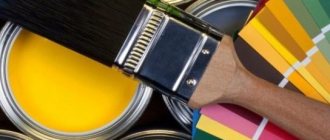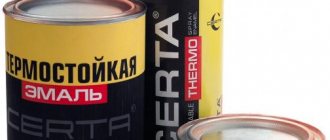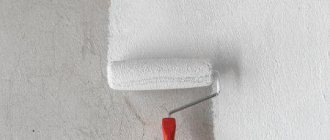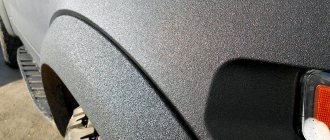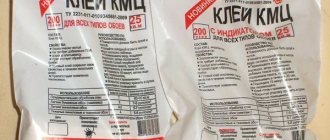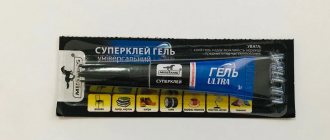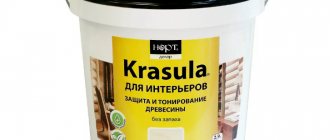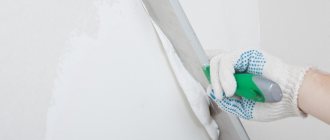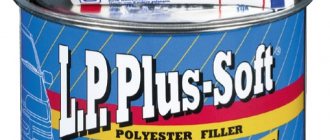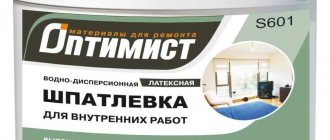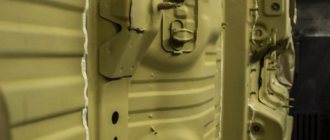We will not do free advertising for certain manufacturers, because most of the offers are similar in quality and cost. We will not delve into the special intricacies of the puttying process, because we can only learn through experience. Let’s focus specifically on the features of individual existing types of putty, because a significant part of mistakes are made at the stage of selecting and preparing the material.
What is classic polyester putty?
Automotive putty is a paste-like material for removing irregularities and dents on body parts before painting. Classic polyester putty consists of two main groups of substances:
- Resins based on modified polyester chemical compounds that determine the plasticity and viscosity, adhesion and polymerization rate of the material.
- Fillers based on mineral insoluble components that affect the strength properties and complexity of further processing of the layer applied to metal or plastic.
When resins and filler are combined, a kind of paste is obtained, into which a hardener based on peroxide initiators must be introduced to start the polymerization process. Depending on the initial composition (type of resins and fillers), coatings with different performance characteristics are obtained, necessary for repairing body parts with varying degrees of damage. But all polyester putties have a number of advantages in common:
- Good mechanical strength while maintaining elasticity.
- Shortened polymerization period.
- It fits perfectly and adheres well (high adhesion) to various surfaces.
- Has slight shrinkage.
It is these performance characteristics of the material that are needed to restore the surface of car body parts. After all, with large shrinkage, it is difficult to stretch out the required thin layer, and inelastic putty will not withstand vibration and deformation of the metal.
For the sake of fairness, let us note the following point. Polyester does not tolerate amateurs and inept hands. Any mistake will lead to the fact that all the benefits will be negated. For this reason, it is important to understand the characteristics of the material, which is suitable for large areas or deep dents, which can be sanded later, and which will not work with such numbers.
Tips and recommendations for use
The body repair process will be easier if you follow some recommendations:
- Before diluting the car putty, you need to mix the putty and hardener well;
- At elevated temperatures, it is necessary to reduce the amount of hardener by half;
- To obtain a thick mixture, you can add a polymer with fiberglass;
- The putty should be stored only in airtight containers;
- On parts with increased vibration, it is recommended to use putty with greater elasticity.
Classification
According to their intended purpose, there are three classes of polyester putties used for repairing metal surfaces and differing in performance characteristics:
- Basic (filling, starting) - compositions with a coarse filler, characterized by increased adhesion to a previously prepared surface. They have increased mechanical strength, but are less amenable to subsequent processing. Recommended application: filling local deep dents and damage when thick layers of material are required. When laying in multiple layers, they can remove dents up to 6–10 mm. This category includes compositions with special additives to the filler that provide increased coating strength.
- Finishing (thin, finishing) - compositions with improved elastic properties obtained through the use of fine-grained filler. The material is used to eliminate minor defects and as a final coating laid on starting putties. The composition applies well to all surfaces, but the layer thickness does not exceed 0.5–0.8 mm. The “finish” is not suitable for removing large dents due to increased shrinkage.
- Universal putties are distinguished by medium-grain filler, which gives them the properties of both starting and finishing compositions. Recommended for application to starting materials with significant metal deformations as intermediate layers. With proper qualifications, craftsmen can sand no worse than finishing putty, but for beginners in body repair, it is still better to apply the final layer with a thinner finishing polyester.
To obtain a high-quality surface suitable for subsequent painting, we recommend applying several layers of putty with a gradual decrease in the grain size of the filler. If you plan to work at a professional level, keep all three classes of materials in stock.
Special filling polyester putties
Often, body repair requires solving non-standard problems. And this is understandable, because one part of the parts is subject to increased heating, another to increased vibration, and over large areas the metal plays due to insufficient rigidity. Try filling the straightened car roof or hood with regular starting and finishing compounds. For such repairs, standard polyesters are not suitable; a material with more advanced performance properties is needed. That’s why manufacturers offer putties that contain special additives as fillers.
With fiberglass
Most of all, manufacturers experiment with putties of this class. Long and short segments of fiberglass are added, the concentration is changed, and the strength characteristics of the material are adjusted. After the composition hardens, a layer of real fiberglass is obtained on the treated surface, which can withstand increased tensile loads. But the elasticity of putties with fiberglass additives is worse. Therefore, it is impossible to use the composition on large surfaces, if it is necessary to apply a thin layer. The material is also not suitable for body parts operating under conditions of increased vibration and increased thermal expansion of the metal. You should not use it, for example, to treat a roof.
We include putties with carbon fiber filler in this same category. The material has the same properties, but weighs less and better reinforces the treated surfaces.
The main purpose of compounds of this class is the processing of power elements: arches, pillars, sills. Recommended for use on deep dents and areas damaged by corrosion. Due to the reinforcing properties of fiberglass, this putty can be used to seal even small through holes.
Advantages of fiberglass putty:
- Can be applied in a thick layer, with virtually no shrinkage observed.
- Increased filling and reinforcing capacity, allowing work in areas that are severely deformed or damaged by corrosion.
- Due to their increased strength, they are used even in areas of metal ruptures and in cases of through damage.
It cannot be used to eliminate minor defects - the material cannot be applied in a thin layer, and subsequent cleaning of fiberglass is a headache.
With aluminum powder
An interesting version of polyester that has become widespread relatively recently. The introduction of aluminum powder into the filler made it possible to obtain a metallized putty on a polyester basis. The coefficient of thermal expansion of the composition of this class is close to that of steel and other metals. Due to this, the hardened coating can easily withstand multiple cooling/heating cycles without cracking or peeling.
The recommended scope of application is body elements subjected to temperature and vibration loads, including parts with a large surface area. Do you need to putty the roof, hood, or engine compartment shield? Choose polyester putty with aluminum powder.
Among the advantages of the material we note:
- Minimal shrinkage in the class of polyester putties.
- Fine-grained structure, due to which the composition is used to eliminate minor defects.
- The putty does not break off at the boundaries and is easily reduced to zero.
- The life span of the mixed composition is increased by a third, making it easier to work with a large surface area.
It is not advisable to use such putty for processing power body elements due to the increased cost of the material.
Lightweight putty
Another new product that deserves attention. Glass beads of microscopic size are introduced into the composition as a filler. Due to this, manufacturers have reduced the specific gravity of the material and simplified subsequent surface grinding. When processed with sandpaper, the filler is not pulled out from the base, but simply erased. The distinctive features of putty include:
- Reduced coating weight by 30–40%.
- Easy to sand within 2-3 days after application.
- Retains elastic properties after polymerization.
These factors determined the scope of application of polyester putties of this class:
- Significant amount of repair work.
- Parts whose processing should not lead to weight.
- Body parts with a large surface area for which fast sanding is important.
The material is used for repairing body elements made of steel, including galvanized steel, and aluminum.
Liquid putty
Compositions of this class reduce the processing time of large areas of metal. The putty is applied to the surface by spraying using standard spray guns or guns used for anti-gravel treatment. Fills uneven spots and small scratches on body parts. The experience of using it as an insulator between the main polyester putty and the paint coating is interesting. The composition prevents the formation of defects caused by incorrect dosage of the hardener in the first layers applied to the metal.
Those who have had to work with materials of this class note the following advantages of putty :
- Good adhesion to metals, certain types of plastic, fiberglass.
- Applies to primed and unprimed surfaces.
- Compatible with almost all types of paints and varnishes used in body repairs.
- It has high elasticity and is easy to use.
Let's pay attention. Liquid polyester putty requires a larger amount of hardener. The ratio varies among products from different manufacturers, but is usually 6-7%. Before starting work, be sure to read the instructions.
Polyester putties for working with plastic
To work with plastic parts, which are widely used by both car manufacturers and tuning studios, you will also need a special putty. The fact is that most standard compounds will react with plastic and simply corrode it. Yes, there are exceptions. Some putties are used on steel, aluminum, and polymers. But only a specialist can select it for each individual bumper. After all, parts are made from different polymers. Therefore, we recommend using special polyester putties for plastic.
The basis of the material is made up of resins, but fine rubber and polymer crumbs are used as filler. Moreover, the composition, including the hardener, is selected in such a way as not to cause harm to plastic parts. The putty has retained its elasticity, which is important, because plastic products are subject to deformation.
Pros and cons of putty for exterior and interior use
The advantages of wood putty for interior work and facade finishing are as follows:
- hydrophobic characteristics of the putty mixture increase the shelf life of wood products and coatings;
- versatility of the material (putty is used for facade and interior decoration, processing of furniture);
- leveling cracks, unevenness, increasing the aesthetics of surfaces;
- the composition is transparent after drying and emphasizes the natural structure of the wood;
- wide selection of putty mixtures;
- high level of adhesion to different surfaces;
- ease of application due to the elastic texture of the putty, etc.
Such a difficult simple preparation of putty for work
It would seem that it could be simpler. Mix it up and putty on yourself little by little. But already at this stage mistakes are made, which are then clearly identified after painting. Therefore, you should not rush and take risks, because repainting it again will cost a pretty penny. Let's learn to read and follow manufacturers' recommendations!
Let's start with the fact that you should not rely on your own skill and ability to quickly putty walls and drywall over large areas. This number will not work with polyester materials. Consider the short pot life of the ready-to-use mixture, which does not exceed 5–6 minutes. After this period, the putty will begin to roll off, and it will not be possible to lay it properly, especially in a thin layer. And the expensive material will have to be thrown away. Always mix small portions of the composition that can be worked out in 3-4 minutes.
The next point is often forgotten. During long-term storage, the resin and filler separate somewhat. The resin becomes covered with a film, and mineral and other additives precipitate. It is unrealistic to choose the correct concentration of hardener for putty in this form. Therefore, before starting work, thoroughly mix all the material in the jar. And only after the entire mass becomes homogeneous can you begin to introduce the hardener.
Most putties are designed to add 2-3% hardener to the base composition. It is believed that 2% is enough in a warm room, and if the temperature is below 15–17 degrees, then add more. The only exception is liquid putties, up to 7% is added to them. And it is at this stage that most mistakes occur. Some people want the putty to last longer, others want it to not harden longer. And experiments begin with the amount of catalyst.
Understand one thing. Increasing or decreasing the hardener does not change the polymerization rate. But it will affect the properties of the resulting layer. Moreover, if the concentration is chosen incorrectly, it will have the most negative effect. See what happens:
- If the amount of hardener is insufficient, the putty hardens for too long, and in some cases never. If you start sanding, you will create lumps and scratches. In this case, we won’t even talk about any high-quality painting.
- If there is an excess volume of catalyst, part of it does not react with the resin. The residue will subsequently begin to interact with the metal, soil, and paintwork. If you see faded spots of paint on the car in the putty areas, you should know that a lot of hardener was introduced when preparing the composition.
And one more thing to remember. Almost all brands of putties have a filler, for example, fiberglass and a brightly colored hardener. Stir the mixture until no clearly visible components of a different color remain. Only when the entire mass becomes homogeneous should you begin to work.
How to apply putty on wood with your own hands?
If you need to restore a small area of a wooden surface, there is no need to call a specialist. This process is easy to do yourself.
Preparing the base for painting
Before starting work, you need to make sure that everything you need is at hand. In addition to putty you will need:
- plastic or metal spatula;
- coarse and fine sandpaper;
- wood primer;
- brush.
Before the main work, the restoration site must be inspected for chips and burrs. Remove excess. After this, sand the wood with coarse sandpaper. When the surface becomes smooth, apply primer with a brush. After drying, you can begin puttying.
If a gap deeper than 5 mm is being filled, it is recommended to first seal it with acrylic sealant or start. In this case, you need to leave 2-3 mm under the putty.
Execution of work
When starting the main work, the mixture must be mixed well. After this, scoop up the required amount of putty with a spatula and move it over the area to be repaired. In this case, the tool must be wider than the gap being sealed. With the next movement, remove the excess. If the depth of the crack is more than 4 mm, putty in several layers no more than 2-3 mm thick.
After completing the steps, you need to wait for the composition to harden. The drying time is indicated on the packaging. Finally, rub in with fine sandpaper and remove any unevenness.
Do you need a primer?
Another question that has generated a lot of controversy. Is it necessary to prime the metal before laying putty? The fact is that manufacturers have also introduced many controversial issues into this topic. Compositions are constantly changing in the process of improvement. Therefore, you can find radically different recommendations.
Let's trust the instructions on the packaging here too. Do as the manufacturer recommends. But if we consider general cases, it is worth highlighting the following points:
- If the composition can be applied to bare metal, then it must be pre-treated with 80-grit sandpaper. In this case, scratches will remain on the surface, the size of which will ensure better adhesion of the materials.
- If we are talking about repairing areas significantly damaged by rust, then it is still worth protecting the metal from subsequent corrosion. Putty has the ability to absorb moisture. And if water gets to the metal, it won’t end well. In such cases, protection with epoxy primers is recommended. They create a reliable barrier to moisture, and the putty fits perfectly on them.
Draw your attention to. Acid primer cannot be used under polyester putty. Materials enter into a chemical reaction with each other. Paint on teak areas will not last long. And also you can’t put polyester on thermoplastic materials.
Analysis of manufacturers' recommendations allowed us to compile a list of surfaces on which polyester putty can be applied:
- Steel surface after preliminary preparation.
- Epoxy primers.
- Other types of polyester putties.
- Paintwork without damage.
Features of working with certain types of auto putties
The technology for applying putties with special fillers is somewhat different from standard work; this is due to certain characteristics of the material. Let's pay attention to the following points:
- Fiberglass putty is difficult to sand. It is not advisable to apply paint directly on it; an additional layer of finishing composition will be required. Therefore, polyester with glass fiber cannot be applied flush with the surface to be treated. Leave 1-2 mm for the finishing coat, which will hide all defects.
- But putty with the addition of aluminum powder fits perfectly and practically does not shrink. Therefore, it is laid flush with the surface. But you should not make an extra slide; after all, the material is also difficult to further process.
- Apply finishing compounds in as small a layer as possible. It is better to lay 2-3 layers. Don't try to solve all the bump problems in one go. The same is true for materials applied by spraying.
And one more point that is typical for all polyester putties without exception. Never sand the prepared surface using water.
Is additional drying necessary?
Almost all types of compositions can be processed after 20–30 minutes after application. Therefore, there is no particular point in additional drying. But sometimes, with large volumes of work, craftsmen resort to this procedure. But it should be remembered that for most compositions the heating temperature should not exceed 60 degrees.
Hair dryers or other heating equipment are used for drying. But in order not to cause cracking of the layer, always heat the metal from the inside, and not from the side of the putty. At the same time, control the heating temperature by touch. The layer may be sensitively hot, but under no circumstances should it burn your fingers.
By the way, an infrared lamp is considered the best device for drying a putty surface. Thanks to uniform heating, it prevents any shrinkage of the material. And the layer will be ready for sanding in 5–7 minutes.
This concludes the review of polyester putties used in body repair. We will talk about surface preparation techniques and putty technology in the following materials on our blog.
AUTO captain:
30.05.2019
` 8042
★★★★★
